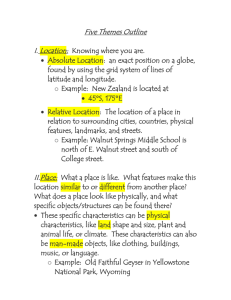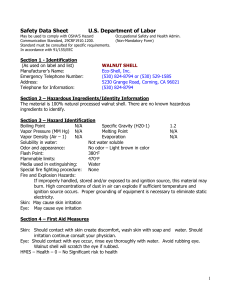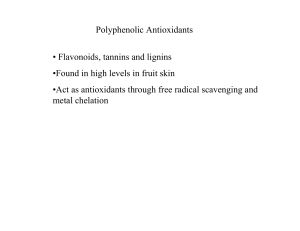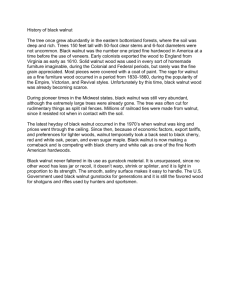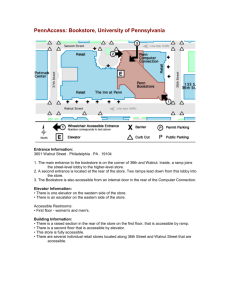Document 14120531
advertisement
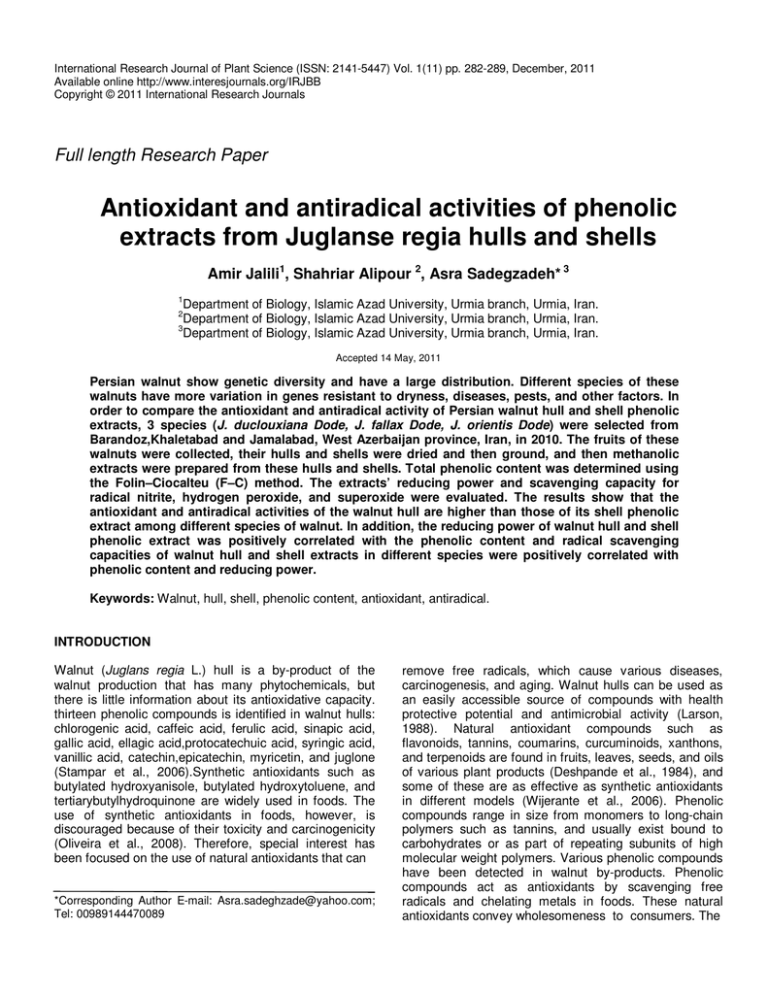
International Research Journal of Plant Science (ISSN: 2141-5447) Vol. 1(11) pp. 282-289, December, 2011 Available online http://www.interesjournals.org/IRJBB Copyright © 2011 International Research Journals Full length Research Paper Antioxidant and antiradical activities of phenolic extracts from Juglanse regia hulls and shells Amir Jalili1, Shahriar Alipour 2, Asra Sadegzadeh* 3 1 Department of Biology, Islamic Azad University, Urmia branch, Urmia, Iran. Department of Biology, Islamic Azad University, Urmia branch, Urmia, Iran. 3 Department of Biology, Islamic Azad University, Urmia branch, Urmia, Iran. 2 Accepted 14 May, 2011 Persian walnut show genetic diversity and have a large distribution. Different species of these walnuts have more variation in genes resistant to dryness, diseases, pests, and other factors. In order to compare the antioxidant and antiradical activity of Persian walnut hull and shell phenolic extracts, 3 species (J. duclouxiana Dode, J. fallax Dode, J. orientis Dode) were selected from Barandoz,Khaletabad and Jamalabad, West Azerbaijan province, Iran, in 2010. The fruits of these walnuts were collected, their hulls and shells were dried and then ground, and then methanolic extracts were prepared from these hulls and shells. Total phenolic content was determined using the Folin–Ciocalteu (F–C) method. The extracts’ reducing power and scavenging capacity for radical nitrite, hydrogen peroxide, and superoxide were evaluated. The results show that the antioxidant and antiradical activities of the walnut hull are higher than those of its shell phenolic extract among different species of walnut. In addition, the reducing power of walnut hull and shell phenolic extract was positively correlated with the phenolic content and radical scavenging capacities of walnut hull and shell extracts in different species were positively correlated with phenolic content and reducing power. Keywords: Walnut, hull, shell, phenolic content, antioxidant, antiradical. INTRODUCTION Walnut (Juglans regia L.) hull is a by-product of the walnut production that has many phytochemicals, but there is little information about its antioxidative capacity. thirteen phenolic compounds is identified in walnut hulls: chlorogenic acid, caffeic acid, ferulic acid, sinapic acid, gallic acid, ellagic acid,protocatechuic acid, syringic acid, vanillic acid, catechin,epicatechin, myricetin, and juglone (Stampar et al., 2006).Synthetic antioxidants such as butylated hydroxyanisole, butylated hydroxytoluene, and tertiarybutylhydroquinone are widely used in foods. The use of synthetic antioxidants in foods, however, is discouraged because of their toxicity and carcinogenicity (Oliveira et al., 2008). Therefore, special interest has been focused on the use of natural antioxidants that can *Corresponding Author E-mail: Asra.sadeghzade@yahoo.com; Tel: 00989144470089 remove free radicals, which cause various diseases, carcinogenesis, and aging. Walnut hulls can be used as an easily accessible source of compounds with health protective potential and antimicrobial activity (Larson, 1988). Natural antioxidant compounds such as flavonoids, tannins, coumarins, curcuminoids, xanthons, and terpenoids are found in fruits, leaves, seeds, and oils of various plant products (Deshpande et al., 1984), and some of these are as effective as synthetic antioxidants in different models (Wijerante et al., 2006). Phenolic compounds range in size from monomers to long-chain polymers such as tannins, and usually exist bound to carbohydrates or as part of repeating subunits of high molecular weight polymers. Various phenolic compounds have been detected in walnut by-products. Phenolic compounds act as antioxidants by scavenging free radicals and chelating metals in foods. These natural antioxidants convey wholesomeness to consumers. The Jalili et al. 283 aim of this research was to determine and compare phenolic content in different species of walnut hull and shell, evaluating their potential antioxidant and antiradical capacity. METHODS Preparation and extraction of fruit samples Fresh fruit samples of juglanse regia(J. duclouxiana Dode, J. fallax Dode, J. orientis Dode) were supplied by the Agricultural and Natural Research Center of West Azerbaijan province from Barandoz, Khaletabad and Jamalabad, West Azerbaijan province, Iran. The hulls and shells of walnut were separated, dried at room temperature, and then reduced to coarse powder. This powder (6 g) was extracted with methanol (100 mL) in a Soxhlet apparatus for 30 min at 80 °C. The methanol extract of walnut hull and shell was evaporated to dryness using a rotary evaporator and stored in the dark at 4 °C until use (Singleton and Rossi, 1965). Total phenolics The content of total phenolics was determined colorimetrically using Folin-Ciocalteus’s phenol reagent, as described by Singleton and Rossi (1965). Briefly, 2.5 mL of 10-fold diluted Folin-Ciocalteu reagent, 2 mL of 7.5% sodium carbonate, and 0.5 mL phenolic extract were mixed well. The absorbance was measured at 765 nm after 15 min heating at 45 °C. A mixture of water and reagents was used as a blank. The phenolic content was expressed as mg gallic acid equivalents per g of extract. Reducing power The reducing power of walnut hull and shell phenolic extracts was determined according to the method of Oyaizu (1986). walnut hull and shell phenolic extract (1 mg/mL), phosphate buffer (1 mL, 0.2 M, pH 6.6), and potassium ferricyanide (1.0 mL, 10 mg/mL) were mixed together and incubated at 50 °C for 20 min. Trichloroacetic acid (1.0 mL, 100 mg/mL) was added to the mixture and centrifuged at 13,400×g for 5 min. The supernatant (1.0 mL) was mixed with distilled water (1.0 mL) and ferric chloride (0.1 mL, 1.0 mg/mL), and then the absorbance was measured at 700 nm. Hydrogen peroxide radical scavenging assay A method described by Ruch et al. (1989) was used to determine the hydrogen peroxide-scavenging ability of walnuts hull and shell extracts. Extracts (1 mg/mL) were dissolved in 3.4 mL of a 0.1 M phosphate buffer (pH 7.4) solution and mixed with 600 µL of a 43 mM solution of hydrogen peroxide (prepared in the same buffer). The concentration of hydrogen peroxide was measured by reading absorbance values at 230 nm of the reaction mixtures. For extracts, a blank sample devoid of hydrogen peroxide was used for background subtraction. Reduction of absorbance in a hydrogen peroxide solution alone due to its degradation was recorded and values were corrected accordingly. The concentration of hydrogen peroxide in the assay medium was determined using a standard curve, and the hydrogen peroxidescavenging effects of the extracts were calculated using the following equation: Superoxide radical scavenging assay For superoxide anion radical assay, the superoxide anion radicals were generated by a pyrogallol autoxidation system (Jing and Zhao, 1995). A volume of 9 mL of TrisHCl buffer solution (50 mmol/l, pH 8.2) was added into a test tube, and the test tube was incubated in a water bath at 25 °C for 20 min. A volume of 40 µL of pyrogallol solution (45 mmol/L of pyrogallol in 10 mmol/L of HCl), which was also pre-incubated at 25 °C, was injected to the above test tube with a microliter syringe and mixed. The mixture was incubated at 25 °C for 3 min and then a drop of ascorbic acid was dripped into the mixture promptly to terminate the reaction. The absorbance at 420 nm marked as A0 was measured 5 min later, and this A0 denotes the speed of pyrogallol autoxidation. The A1 autoxidation speed was obtained applying the above method and with the addition of a certain concentration (1 mg/mL) of extract into the Tris-HCl buffer solution. Simultaneously, a blank control of reagent was obtained as A2. The scavenging percentage was calculated according to the following formula: Superoxide radical scavenging effect (%) = A0 – (A1 – A2) × 100/A0 Nitric oxide radical scavenging assay Nitric oxide radical inhibition can be estimated by the use of Griess Illosvoy reaction (Garrat, 1964). In this investigation, Griess Illosvoy reagent was modified by using naphthyl ethylene diamine dihydrochloride (0.1% w/v) instead of 1-napthylamine (5%). The reaction mixture (3 mL) containing sodium nitroprusside (10 mM, 2 mL), phosphate buffer saline (0.5 mL), and walnut hull and shell phenolic extract (1 mg/mL) was incubated at 25 °C for 150 min. After incubation, 0.5 mL of the reaction mixture was mixed with 1 mL of sulfanilic acid reagent (0.33% in 20% glacial acetic acid) and allowed to stand 284 Int. Res. J. Biochem. Bioinform. for 5 min for completing diazotization. Then 1 mL of naphthyl ethylene diamine dihydrochloride was added, mixed, and allowed to stand for 30 min at 25 °C. A pink coloured chromophore is formed in diffused light. The absorbance of these solutions was measured at 540 nm against the corresponding blank solutions. The nitric oxide-scavenging capacities of the extracts were calculated using the following equation: Nitric oxide radical scavenging effect (%) = A Blank – A Sample × 100/A Sample Statistical analysis All data were expressed as mean ± standard deviation of three independent replicates. One-way ANOVA was applied to determine the significance of results between different treatments. All the statistical analyses were done using SPSS v.11.5 for Windows. RESULTS AND DISCUSSION A few studies were carried out on the total phenolics of walnut hull and shell. Phenolic compounds are the most active natural antioxidants in plants (Bors et al., 2001). They are known to act as antioxidants not only because of their ability to donate hydrogen or electrons but also because they are stable radical intermediates (Cuvelier et al., 1992). Generally, the outer layers of plants such as the peel, shell, and hull contain large amount of polyphenolic compounds to protect the inner materials. A number of phenolic acids are linked to various cell wall components such as arabinoxylans and proteins (Harris and Hartley, 1976). Free radicals possess an unpaired electron, which makes them highly reactive. Antioxidants neutralize free radicals by donating a hydrogen atom to them. Attempts have been made to evaluate the effectiveness of antioxidants in scavenging free radicals such as ABTS radical anion (ABTS•−) and DPPH•, hydroxyl HO•, and superoxide O2•− radicals (Van den berg et al., 2000). In all these methods, antioxidant efficacies are measured at room temperature, thus eliminating any risk of thermal degradation of the molecules being tested. Different solvent extractions provide different types of compounds because of their variable chemical nature and sensitivity toward extraction or hydrolysis methods. As seen with walnut, diethyl ether, methanol, ethyl acetate, and n-butanol, which have been used to extract phenolic compounds in walnut skins, shells and hulls, have resulted in different components in their extraction. Pinelo et al. (2004), in order to optimize the yield of phenolic compounds, showed that among the 3 solvents (ethanol, methanol, and water) ethanol was the most favourable for total extractables, although methanol was more selective for extracting poly phe- nolics. Therefore, in this study we used methanol as a solvent for the extraction of phenolic compounds from walnut hulls and shells. In this study, the average of total phenolic content in 3 walnut hull phenolic extracts was 46.86 ± 1.32 mg gallic acid equivalents/g extract. The maximum total phenolics content in hull extract was 68.3 ± 1.86 mg/g for J. duclouxiana Dode and minimum total phenolics content was 28.7 ± 0.84 mg/g for J. fallax Dode. The content of total phenolics in walnut hull extract reported by Rahimipanah et al. (2010), Stampar et al. (2006), and oliveria et al. (2008) were 3428.11±135.80 mg gallic acid equivalent per 100 gram of dry sample, 1526 ± 111mg/100 g of dry weight and 32.61 to 74.08 mg gallic acid in aqueous extracts, respectively. The average of total phenolics content in 3 walnut shell phenolics extract was 22.73 ± 0.73 mg gallic acid equivalents/g extract. The highest total phenolics content of shell extract, 30.1 ± 1.09 mg/g, was obtained for J. duclouxiana, and the lowest phenolics content of shell extract 13.4 ± 0.43 mg/g for J. fallax Dode. This study shows that the average of total phenolics content in 3 walnut hulls extract (46.86 ± 1.32 mg/g) was abought two times higher than that of their shell extract (22.73 ± 0.73 mg/g). This indicates that the total phenolic of walnut hull extract was higher than that of its shell in different walnut species. The antioxidant properties of phenolic compounds are associated with their reducing power (Jayaprakasha et al., 2001), which is associated with the presence of reductones (Duh, 1998). The reducing power of walnut hull and shell in different species increases significantly with phenol content. In addition, the phenolic content and reducing power of walnut hull and shell vary among species (Figures 1 and 2). The average reducing power values in 3 walnut hulls phenolics extract was 0.312 AU at 700 nm. Maximum reducing power was 0.524 for J. duclouxiana Dode and minimum reducing power was 0.154 for J. fallax Dode. The average reducing power values in 3 wild walnut shell phenolics extract of 0.148 was achieved. Maximum reducing power was 0.176 for J. duclouxiana Dode and minimum reducing power among walnut shell extract was 0.126 for J. fallax Dode. The average of reducing power values in walnut hull extract (0.312) was higher than that of their shell extract (0.148). Accordingly, the reducing power of walnut hull extract was higher than that of its shell extract in different species of walnut. The hydrogen peroxide scavenging activity of walnut hull and shell methanolic extracts were phenol content dependent; species with high phenolic content scavenged most of the hydrogen peroxide (Figure 3). In this investigation the average of hydrogen peroxide radical scavenging percentage in 3 walnut hull phenolics extract was 39.67 ± 1.41%. Maximum hydrogen peroxide radical scavenging percentage was 53.28 ± 1.53% for J. duclouxiana Dode and the minimum hydrogen peroxide radical scavenging percentage was 29.51 ± 1.29% for J. fallax Dode. The Jalili et al. 285 Figure 1: Phenolic content of 3 walnut hull and shell extracts (mg Gallic acid equivalents/g methanolic extract): 1- J. duclouxiana Dode, 2- J. fallax Dode, 3- J. orientis Dode.Means of 3 replicates with standard errors, P < 0.05. Figure 2: Reducing power of 3 walnut hull and shell phenolic extracts: 1- J. duclouxiana Dode, 2- J. fallax Dode, 3- J. orientis Dode. (mean ± S.D., n = 3), P < 0.05. Figure 3: Scavenging percentage for radical peroxide in 3 walnut hull and shell extracts: 1- J. duclouxiana Dode, 2- J. fallax Dode, 3- J. orientis Dode. (mean ±S.E., n = 3), P < 0.05 average of hydrogen peroxide radical scavenging percentage in 3 walnut shell extract was 25.91 ± 0.81%. The maximum hydrogen peroxide radical scavenging percentage was 30.12 ± 0.73% for J. duclouxiana Dode and minimum hydrogen peroxide radical scavenging percentage among walnut shell extract was 20.07 ± 1.09% for J. fallax Dode. The average of hydrogen peroxide radical scavenging percentage of 3 walnut hull phenolics extract (39.67 ± 1.41%) was higher than that of their shell extract (25.91 ± 0.81%). This indicates that hydrogen peroxide radical scavenging percentage of walnut hull phenolics extract was higher than that of its 286 Int. Res. J. Biochem. Bioinform. Figure 4. Scavenging percentage for radical superoxide in 3 walnut hull and shell extracts: 1- J. duclouxiana Dode, 2- J. fallax Dode, 3- J. orientis Dode. (mean ±S.E., n = 3), P < 0.05. shell in different walnut species. The rates of hydrogen peroxide scavenging of hull and shell varied among species too. Thus, hydrogen peroxide scavenging activity of walnuts hull and shell extracts in some spcies (for example J. duclouxiana Dode) would contribute to their inhibition of lipid peroxidation and thereby protect cells from oxidative damage. We evaluated the scavenging capacity of walnut hull and shell extracts towards superoxide anion radicals by using a pyrogallol autoxidation system. Pyrogallol can autoxidate fast in alkali conditions and release superoxide anions and the superoxide anions can accelerate the autoxidation. However, the superoxide anions can be scavenged by adding some scavenger or antioxidant, the autoxidation will thus be depressed. As shown in Figure 4, the inhibition effects of walnut hull and shell extracts on the autoxidation of pyrogallol were relatively feeble in species with lower phenolic content, but the walnut hull and shell extract with high phenolic content exhibited strong inhibition activities. This indicates that walnut hull and shell, in particular hull extract has a strong inhibition effect on the autoxidation of pyrogallol. In other words, it can scavenge the superoxide anion radicals generated by the pyrogallol autoxidation system effectively. The average of superoxide radical scavenging percentage in 3 walnut hull phenolic extract 54.75 ± 1.34% was obtained. Maximum superoxide radical scavenging percentage was 67.31 ± 1.48% for J. duclouxiana Dode and minimum superoxide radical scavenging percentage was 36.84 ± 1.22% for J. fallax Dode. The average of superoxide radical scavenging percentage in 3 walnut shell extract was 38.29 ± 1.19%. The maximum superoxide radical scavenging percentage was 49.58 ± 1.24% for J. duclouxiana Dode, and the minimum hydrogen peroxide radical scavenging percentage among walnut shell extract was 31.11 ± 1.03% for J. fallax Dode. This study shows that the superoxide radical scavenging percentage of walnut hull phenolic extract was higher than that of its its shell in different walnut species. Nitrite has long been applied in the processing of meat products as a preservation agent and color agent. The nitrate occurring in many vegetables can also be transformed to nitrite by reduction reactions with the action of bacteria in human bodies. These nitrites may be transformed into nitrosamines combining with secondary and tertiary amines in human bodies. These nitrosamines are procarcinogenic substance (Bartsch and Montesano, 1984). Thus, if some substance can scavenge nitrosamine or its precursor substance such as nitrite, it probably has protective functions. In this investigation the average nitric oxide radical scavenging percentage in 3 walnut hull phenolic extract was 41.70 ± 1.67%. The maximum nitric oxide radical scavenging percentage was 55.71 ± 1.97% for J. duclouxiana Dode and the minimum nitric oxide radical scavenging percentage was 32.97 ± 1.38% for J. fallax Dode. The average nitric oxide radical scavenging percentage in 3 walnut shell extract was 25.61 ± 0.92%. The maximum nitric oxide radical scavenging percentage was 29.83 ± 0.86% for J. duclouxiana Dode, and the minimum nitric oxide radical scavenging percentage among walnut shell extracts was 19.87 ± 1.17% for J. fallax Dode. This investigation shows that the nitric oxide radical scavenging percentage of walnut hull phenolic extract was higher than that of its shell in different walnut species. In addition, the nitric oxide radical scavenging activity of walnut hull extract has for the first time shown that walnut hull phenolic extract is a potent scavenger of nitric oxide. As shown in Figure 5, the scavenging capacities of walnut hull and shell phenolic extracts towards nitrite varies relatively among species, and the scavenging activities are obviously stronger in species with high phenolic content. This indicates that Walnut hull extract and shell phenolic extract, in particular hull extract, are also excellent nitrite scavengers. The results of correlation analyses between the total phenolic content, reducing power antioxidant, and antiradical activities are depicted in Figures 6 and 7. Jalili et al. 287 Figure 5: Scavenging percentage for radical nitrate in 3 walnut hull and shell extracts: 1- J. duclouxiana Dode, 2- J. fallax Dode, 3- J. orientis Dode. (mean ±S.E., n = 3), P < 0.05. B A 60 0.6 50 0.5 40 0.4 30 0.3 0.2 20 y = 0.6093x + 11.121 10 0.1 0 0 0 50 y = 0.0095x - 0.1326 0 100 D 80 70 60 50 40 30 20 10 0 50 40 30 20 y = 0.595x + 13.821 10 0 50 100 C 60 0 50 100 y = 0.7212x + 20.956 0 50 100 Figure 6: Correlations between the total phenolic content of walnut hull and observed antioxidant activity from reducing power (A),scavenging percentage for hydrogen peroxide (B), superoxide (C), and nitrite (D) radicals, P < 0.05. 288 Int. Res. J. Biochem. Bioinform. B 35 30 25 20 15 10 5 0 A 0.2 0.15 0.1 y = 0.6093x + 11.121 0.05 y = 0.0095x - 0.1326 0 0 20 40 0 20 40 C D 60 35 50 30 25 40 20 30 15 20 10 10 y = 0.7212x + 20.956 5 y = 0.595x + 13.821 0 0 0 20 40 0 20 40 Figure 7: Correlations between the total phenolic content of walnut shell and observed antioxidant activity from reducing power (A),scavenging percentage for hydrogen peroxide (B), superoxide (C), and nitrite (D) radicals, P < 0.05. A statistically significant (P < 0.05) correlation was found with total phenolics versus antiradical activity and reducing power. Using a 4-point correlation between total phenolics and antioxidant activity, the data were significant at P < 0.05. The strong correlation between the content of total phenolics and reducing power has been found in the extracts of selected plant species from the Canadian prairies, as reported by Amarowicz et al. (2004). Velioglu et al. (1998) examined 28 plant products and found a significant relationship between the total antioxidant activity and total phenolics in flaxseed and cereal products. CONCLUSION In conclusion, the results of the present study apparently indicated that Persian walnut by-products constitute a suitable source of phenolics and can be used as alternative natural antioxidants in food industries. phenolic extracts from walnut hulls and shells possess antioxidant and antiradical activity, which could vary in different species, and this phenolic extract may be helpful in preventing or stopping the progress of various oxidative stress-related diseases. However, to use the extracts of these phenolic compounds as an antioxidant in foods, methanol should be substituted with some harmless solvent, although water is not as effective as organic solvents to extract useful compounds from plants by-products. REFERENCES Amarowicz R, Pegg RB, Rahimi-Moghaddam P (2004). Freeradical scavenging capacity and antioxidant activity of selected plant species from the Canadian prairies. Food Chem. 84: 551-562. Bartsch H, Montesano R (1984). Relevance of nitrosamines to human cancer. Carcinogenesis 5: 1381-1393. Bors W, Michel C, Stettmaier K (2001). Structure–activity relationships governing antioxidant capacities of plant polyphenols. Methods Enzymol. 335: 166-180. Cuvelier ME, Richard H, Berset C (1992). Comparison of the antioxidant activity of some acid phenols: structure–activity relationship. Biosci. Biotech. Biochem. 56: 324-325. Deshpande SS, SK. Sathe and DK. Salunkhe. (1984). Chemistry and safety of plant polyphenols, In: Friedman M, ed. Nutritional and toxicologial aspects of food safety. Plenum Press, New York. Pp: 457-495. Duh PD (1998). Antioxidant activity of budrock (Arctium lappa L.): its scavenging effect on free radical and active oxygen. J. Ame. Oil Chem. Soc., 75: 455-461. Garrat DC (1964). The Quantitative analysis of drugs. Chapman and Hall ltd, Japan. 3: 456-458. Harris PJ, Hartley RD (1976). Detection of bound ferulic acid in cell walls of the gramineae by ultraviolet fluorescent microscopy. Nat, 259: 508-510. Jayaprakasha GK, Singh RP, Sakariah KK (2001). Antioxidant activity of grape seed (Vitis vinifera) extracts on peroxidation models in vitro. Food Chem., 73: 285-290. Jing TY, Zhao XY (1995). The improved pyrogallol method by using terminating agent for superoxide dismutase measurement. Biochem Jalili et al. 289 Biophys 22: 84-86. Larson RA (1988). The antioxidants of higher plants. Phytochem 27: 969-978. Oliveira I, Sousa A, Ferreira IC, Bento A, Estevinho L, Pereira JA (2008). Total phenols, antioxidant potential and antimicrobial activity of walnut (Juglans regia L.) green husks. Food and Chem.Toxicol., 46:2326-2331. Oyaizu M (1986). Studies on products of browning reaction: antioxidative activities of products of browning reaction prepared from glucosamine. Jap. J. Nutr., 44: 307-315. Pinel M, Rubilar M, Sineiro J (2004). Extraction of antioxidant phenolics from almond hulls (Prunus amygdalus) and pine sawdust (Pinus pinaster). Food Chem., 85: 267-273. Rahimipanah M, Hamedi M Mirzapour M (2010). Antioxidant activity and phenolic contents of Persian walnut (Juglans regia L.) green husk extract. Afri. J. Food Sc. and Technol., (ISSN: 2141-5455). 1(4): 105-111. Ruch RJ, Cheng ST, Klauring JE (1989). Prevention of cytotoxicity and inhibition of intercellular communication by antioxidant catechins isolated from Chinese green tea. Carcinogenesis 10: 1003-1008. Singleton VL, Rossi JA (1965). Colorimetry of total phenolics with phosphomolybdic– phosphotungstic acid reagents. J Am Enol Vitic 16: 144-158. Stampar F, A. Solar, M. Hudina, R. Veberic and M.Colaric (2006). Traditional walnut liqueur – cocktail of phenolics. Food Chem., 95:627-631. Van den berg R, Haenen G, Van den berg H (2000). The predictive value of the antioxidative capacity of structurally related flavonoids using the trolox equivalent antioxidant capacity (TEAC) assay. Food Chem., 70: 391-395. Velioglu YS, Mazza G, Gao L (1998). Antioxidant activity and total phenolics in selected fruits, vegetables, and grain products. J Agric Food Chem 46: 4113-4117. Wijerante SSK, Abou-Zaid MM, Shahidi F (2006). Antioxidant polyphenols in almond and Its co products. J. Agric. Food Chem., 54: 312-318.
